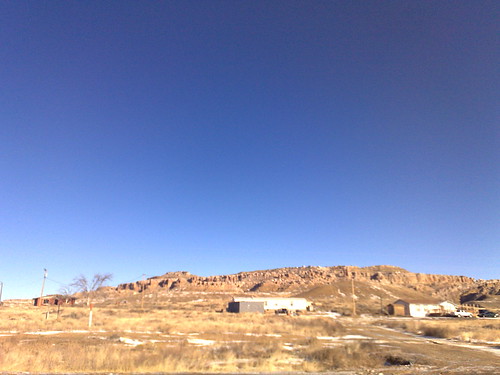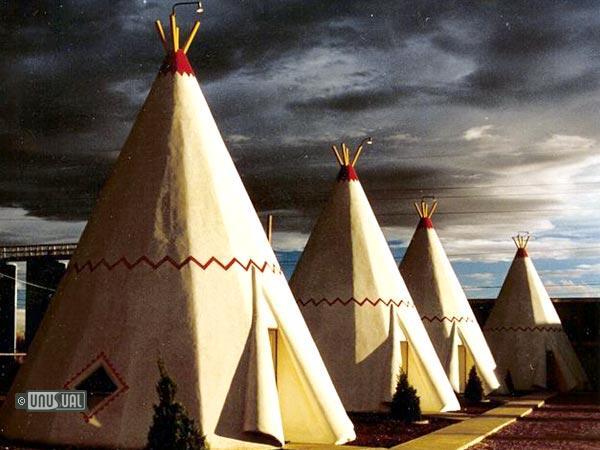Blue Highways: Hotevilla, Hopi Reservation
Unfolding the Map
Click on Thumbnail for MapA little bit of a rambling, somewhat disjointed post for you this time, covering cops, wind, tumbleweeds, and journeys as destinations. Also a little bit of original poetry, and The Marvelettes. What would a "thought" blog about literature be without some jumping around once in a while? Click on the thumbnail of the map to learn where Hotevilla is located.
Book Quote
"A tribal squadcar checked my speed at Hotevilla, where the highway started a long descent off the mesa. The wind was getting up, and tumbleweed bounded across the road, and sand hummed against the Ghost. West, east, north, south - to each a different weather: sandstorm, sun, rain, and bluish snow on the San Francisco Peaks, that home of the Kachinas who are the spiritual forces of Hopi life."
Blue Highways: Chapter 5, Part 2
 Water tower in Hotevilla, Hopi Reservation. Photo by "nativeone28" and hosted at Panoramio. Click on photo to go to host page.Hotevilla, Hopi Reservation
Water tower in Hotevilla, Hopi Reservation. Photo by "nativeone28" and hosted at Panoramio. Click on photo to go to host page.Hotevilla, Hopi Reservation
I have been stopped by police twice in my life. One was when I was in high school. Our road had a new stop sign on it, but people in my neighborhood who were used to driving straight through with no stops usually ignored the stop sign. It got so bad that they stationed a highway patrol car just out of sight. One night, I think I was around 16 at the time, I did a rolling stop where I didn't really come to a complete stop. All of a sudden there were flashing lights. The patrolman did the patrolman thing - he asked me if I knew why he stopped me - and I knew but it was all new to me and I was a bit intimidated. But he let me go with a warning.
The second time was about 3 years ago. I was traveling back to my job in Lubbock from Albuquerque after a weekend of seeing my wife. About 30 miles across the Texas line, I was pulled over by a state trooper. He had clocked me going 75 in a 65 mile an hour zone. There wasn't much traffic on the road and it was probably about 11:00 at night, so he let me off with a warning also.
The interesting thing about that drive was that it was very reminiscent of LHM's description of tumbleweeds and sand. Tumbleweeds may be a symbol of the old West, but when you drive through a windstorm and there are dozens of them blowing across the road, they are a bit of a menace. They can also do some pretty heavy damage to your car. If you hit one just right, it can puncture a radiator or an oil pan. At night, they seemed to often fly out of nowhere right at you. When I would drive the stretch between Fort Sumner and Santa Rosa, New Mexico where there was lots and lots of open land and no buildings, it was almost as if the night were throwing the tumbleweeds at me, testing my ability to dodge and weave.
Living in New Mexico is probably a lot like living on the Hopi Reservation. The area is arid, and windy. The wind usually blows from the west, kicking up the dry sand. As I write this, today we are having sixty mile-per-hour gusts outside, and the horizon is obscured because of all the dust and grit in the air. Walking outside leaves grit in your mouth and in your teeth. To me, the four directions in New Mexico are as such: north-coolness; east-mountains; south-hotness; west-wind. The wind here, especially in spring, is a force to be reckoned with. It gets into your head. I ride a bike as my transportation to and from work, and the worst part of my ride in the spring is that in the morning, the wind is blowing against me on my downhill ride to the office, and in the afternoon it has switched around to oppose me on my ride home.
I imagine that living on a mesa, one might cling to the land because it might seem that if one stops clutching, one might be blown off the mesa into the ether. If one believes in cloud people as the Hopi believe in the Kachina, I can see how easy it would be to believe that the wind could carry us if we don't hold on for dear life. If it can carry the Kachina on their journeys to the Hopi people in order to teach and convey important messages, it might also take us ordinary folk away to places or worlds unknown. It is better to hold ourselves down here than face that kind of unknown.
But for me, the choice is between being a stone, affixed to the earth and slowly being worn away by the elements piece by piece until there is nothing left of me, or being a tumbleweed and being blown about to places the wind wants to take me. At times in my life, such as now, I want to be rooted to a place and not move. At other times, I want to be like LHM, riding along in my van like a tumbleweed to places unknown. Either way, as long as I'm happy in what I'm doing, it's all good.
I'll inflict another poem on you that I wrote, which gets to this kind of feeling and fits with my reflection on wind also. I wrote it after breaking up with someone:
Autumn Thoughts
A click, and then a lifeless, droning hum
As I dropped my phone, now overcome with shock;
I walked outside, into the setting sun
And sat upon the grass with burdened thoughts.
A cavalcade of brightly colored leaves
Ran helter-skelter down the somber street,
Driven by a soft, yet forceful breeze
That pushed them onward to an unknown fate.
How I wished that I could join them there,
And also dance away my lonely grief,
Until, with growing pain, I was aware,
That life is but the wind, and I a leaf.
I thought of love and loss, and thus entranced,
Ran out into the street to join the dance.
Michael L. Hess
A friend told me today that her revelation is that the journey is the destination. I'm still thinking about that and what it means, but somehow, it makes complete sense. We are all on journeys, but sometimes, the journey and not the destination is what we need to understand ourselves and our lives.
Musical Interlude
Not sure why, but The Marvelettes' hit song Destination Anywhere is speaking to me right now. Enjoy!
If you want to know more about Hotevilla
Final Message from Hotevilla by Hopi Eldest Elder Dan Evehema
Truth of a Hopi: How Hotevilla and Bakabi were founded
Wikipedia: Hotevilla-Bacavi
Next up: Tuba City, Navajo Nation




 Friday, April 15, 2011 at 6:09PM
Friday, April 15, 2011 at 6:09PM


